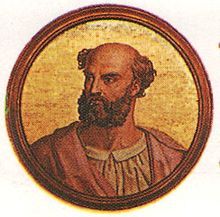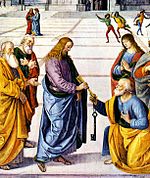- Pope Damasus II
-
Damasus II 
Papacy began July 17, 1048 Papacy ended August 9, 1048 Predecessor Benedict IX Successor Leo IX Personal details Birth name Poppo Born ???
Pildenau, Duchy of Bavaria, Holy Roman EmpireDied August 9, 1048
Palestrina, Papal States, Holy Roman EmpireOther Popes named Damasus Pope Damasus II (died August 9, 1048), born Poppo,[1] Pope from July 17, 1048 to August 9, 1048, was the second of the German pontiffs nominated by Emperor Henry III (1039–56). A native of Bavaria, he was the third German to become Pope and had one of the shortest papal reigns. His original name was Poppo, and he was bishop of Brixen when the Emperor raised him to the papacy.
Contents
Imperial nomination
Given the display of imperial power Henry III had inflicted on the Romans in intervening against Pope Gregory VI and installing Clement II, it is unsurprising that on Christmas Day 1047, an emissary was sent by the Roman people, bringing tidings of Clement II's death to Henry III, and asking the Emperor, in his position as Patricius of the Romans to appoint a successor. Henry had been engaged in an indecisive campaign in Frisia, and was in his palace at Pöhlde in Saxony when the embassy found him. The envoys, according to their instructions, suggested as a suitable candidate, the handsome Halinard, Archbishop of Lyon, who was a fluent speaker of Italian, and was well respected in Rome.
Henry though was unwilling to rush matters, and so asked Wazo of Liège, the most independent bishop within the empire, who ought to be made pope. After careful consideration, Wazo declared that the most appropriate candidate for the vacant papal throne was the man the emperor had removed – Gregory VI. Wazo's deliberations had taken time, and Henry had soon lost patience. Henry had instead appointed Poppo, Bishop of Brixen in Tyrol, a proud man of distinguished learning,[2] who had taken part in the Synod of Sutri. This decision antagonized the Romans who were still pushing for Halinard to become the new Pope. Nevertheless, Henry sent the Roman envoys back to Rome with great presents, to prepare for the arrival of their new Pope.
Arrival in Italy
During the envoys’ absence, imperial authority in Rome had been virtually extinguished, as the Tusculan faction reasserted its power. The former pope, Benedict IX, residing at Tusculum had been intently watching the situation in Rome, and had decided that now was his opportunity to reclaim what was his. He approached the Margrave Boniface III of Tuscany for help, and Boniface, who did not like the emperor, was easily convinced to help anyone who would disrupt Henry's authority. After Benedict had used his extensive supply of gold to gain a large number of followers, the Margrave's influence enabled him to occupy the papal throne for over eight months, from November 8, 1047 until July 17, 1048.
In the meantime, Henry was marching down towards Italy with Poppo, accompanying him at least as far as Ulm (in Württemberg) on the Danube.[2] Here it came to light that the papal exchequer was close to bankrupt, and so Poppo was allowed to retain the revenues of his see. In addition, a deed was drawn up on January 25, 1048, granting Poppo an important forest in the valley of Puster. Having done this, and unable to leave Germany in case there might be an uprising during his absence, he directed the Margrave Boniface to conduct the Pope-designate to Rome in person, and in the emperor's name to arrange for the enthroning of the new Pope.
Given his role in the usurpation of Benedict IX, and his attitude towards Henry III, it is unsurprising that Boniface at first refused, advising Poppo when he entered Tuscany, "I cannot go to Rome with you. The Romans have again installed Benedict, and he has won over the whole city to his cause. Besides, I am now an old man."[3] Having nowhere to turn, and unable to proceed, Poppo had no choice but to turn around and return to Germany, where he informed Henry of what had transpired.
Papal coronation
Upon receiving the news, Henry was furious. Poppo was quickly sent back to Boniface, carrying with him a letter from the emperor which ordered him to arrange the expulsion of Benedict and the enthroning of his successor. Henry was simple and direct. "Learn, you who have restored a Pope who was canonically deposed, and who have been led by love of money to despise my commands, learn that, if you do not amend your ways, I will soon come and make you."[4] These threats soon reduced Boniface to obedience. He sent a body of troops into Rome and forcibly expelled Benedict from the city.
After Benedict IX's removal, the Bishop of Brixen entered the city in triumph, as the Romans, with every demonstration of joy, welcomed the bishop who would be Pope. He was enthroned at the Lateran as Pope Damasus II on July 17, 1048. His pontificate, however, was of short duration. Overcome, in all likelihood, by the heat of Rome, he retired to Palestrina, but it was too late. After a brief reign of twenty-three days, he died on August 9, and was buried in San Lorenzo fuori le Mura. According to Panvinio (died 1568), Damasus’ sarcophagus was large and "adorned with reliefs representing a vineyard, with cupids as the wine gatherers."[5]
The shortness of Damasus II's reign led to rumors that he had been poisoned by a man named Gerhard Brazutus, a friend of Benedict IX and a follower of Hildebrand. However, the source for this information is extremely suspect,[6] and a more likely scenario is that he died of malaria.
Notes
References
 "Pope Damasus II" in the 1913 Catholic Encyclopedia.
"Pope Damasus II" in the 1913 Catholic Encyclopedia.- Mann, Horace K., The Lives of the Popes in the Early Middle Ages, Volume 5: The Popes In The Days of Feudal Anarchy, from Formosus to Damasus II, Part 2 (London, 1910)
Footnotes
Catholic Church titles Preceded by
Benedict IXPope
1048Succeeded by
Leo IXCatholic Church Organizations, Papacy, Teachings and Liturgical TraditionsHistory Jesus · Twelve Apostles · Early Christianity · History of the Papacy · Ecumenical Councils · Missions · Great Schism of East · Crusades · Great Schism of West · Protestant Reformation · Counter-Reformation · Catholic Church by country
Hierarchy Pope · Cardinals · Patriarchs · Major Archbishops · Primates · Metropolitans · Archbishops · Diocesan BishopsTheology Sacraments Mariology Doctors of
the ChurchAlbertus Magnus · Ambrose · Anselm of Canterbury · Anthony of Padua · Thomas Aquinas · Athanasius of Alexandria · Augustine of Hippo · Basil of Caesarea · Bede · Robert Bellarmine · Bernard of Clairvaux · Bonaventure · Petrus Canisius · Catherine of Siena · Peter Chrysologus · John Chrysostom · Cyril of Alexandria · Cyril of Jerusalem · Peter Damian · Ephrem the Syrian · Francis de Sales · Gregory of Nazianzus · Gregory the Great · Hilary of Poitiers · Isidore of Seville · Jerome · John of Damascus · John of the Cross · Lawrence of Brindisi · Leo the Great · Alphonsus Maria de Liguori · Teresa of Ávila · Thérèse of LisieuxPope Benedict XVI Preceding Popes Orders and
SocietiesVatican II Particular Churches
sorted by
Liturgical TraditionsAlexandrian · Coptic · Ethiopic · Antiochian · Maronite · Syriac · Syro-Malankara · Armenian · Armenian · Byzantine · Albanian · Belarusian · Bulgarian · Croatian · Greek · Hungarian · Italo-Albanian · Macedonian · Melkite · Romanian · Russian · Ruthenian · Slovak · Ukrainian · East Syrian · Chaldean · Syro-Malabar · Latin · Roman · Anglican Use · Sarum · Ambrosian · MozarabicHistory of the Catholic Church General History of the Catholic Church · History of the Papacy · History of the Roman Curia · Catholic Ecumenical Councils · Timeline of the Catholic Church · History of Christianity · Role of the Catholic Church in Western civilization · Art in Roman Catholicism · Catholic religious order · Christian monasticism · Papal States
Church beginnings Constantine the Great to
Pope Gregory IConstantine the Great and Christianity · Arianism · Basilica of St. John Lateran · First Council of Nicaea · Pope Sylvester I · First Council of Constantinople · Biblical canon · Jerome · Vulgate · First Council of Ephesus · Council of Chalcedon · Benedict of Nursia · Second Council of Constantinople · Pope Gregory I · Gregorian chant
Early Middle Ages Third Council of Constantinople · Saint Boniface · Byzantine Iconoclasm · Second Council of Nicaea · Charlemagne · Pope Leo III · Fourth Council of Constantinople · East–West Schism
High Middle Ages Pope Urban II · Investiture Controversy · Crusades · First Council of the Lateran · Second Council of the Lateran · Third Council of the Lateran · Pope Innocent III · Latin Empire · Francis of Assisi · Fourth Council of the Lateran · Inquisition · First Council of Lyon · Second Council of Lyon · Bernard of Clairvaux · Thomas Aquinas
Late Middle Ages Protestant Reformation/
Counter-ReformationBaroque Period to the
French Revolution19th century Pope Pius VII · Pope Pius IX · Dogma of the Immaculate Conception of the Virgin Mary · Our Lady of La Salette · Our Lady of Lourdes · First Vatican Council · Papal infallibility · Pope Leo XIII · Mary of the Divine Heart · Prayer of Consecration to the Sacred Heart · Rerum Novarum
20th century Pope Pius X · Our Lady of Fátima · Persecutions of the Catholic Church and Pius XII · Pope Pius XII · Pope Pius XII Consecration to the Immaculate Heart of Mary · Dogma of the Assumption of the Virgin Mary · Pope John XXIII · Second Vatican Council · Pope Paul VI · Pope John Paul I · Pope John Paul II
21st century By country or region Brazil · Cuba · France · Germany · Hispano-America · Ireland · Japan · Mexico · Spain · United States · Venezuela
Categories:- Popes
- German popes
- 11th-century archbishops
- 11th-century German people
- 1048 deaths
- People from Rottal-Inn
Wikimedia Foundation. 2010.

